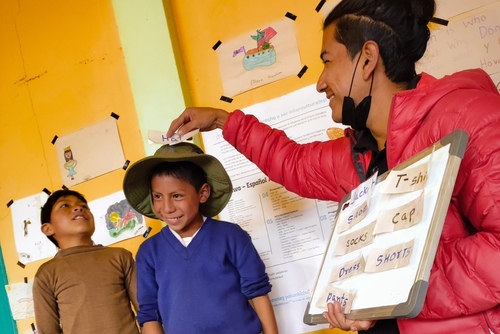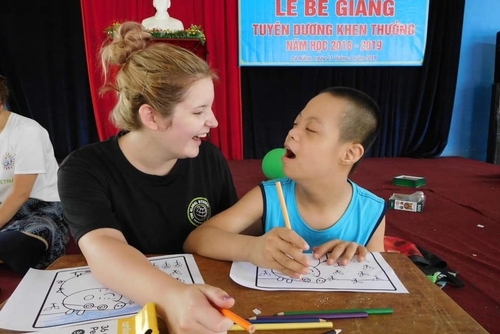Todd Squitieri from the United States took a TEFL course with the International Teacher Training Organization (ITTO) in Guadalajara, Mexico and was able to fulfill a dream of living and working as an English teacher.
Todd went to teach in South Korea and arranged his experience through Korean Horizons.
In this article Todd shares his experience of teaching abroad for the first time and top tips for trying to get Korean students to learn and improve their English skills.
What is it Like Working in a Korean Classroom?
I’m not going to lie, working in a new environment with the language barrier was a challenge and some days were very tough. But there are lots of helpful techniques, activities and games you can do to make the whole experience easier.
Some activities students can do on their own or with minimal help and are designed for students to explore the language on their own terms and at the level that they are most comfortable with. And then there are also activities that are both fun and helpful.
In many respects, these activities function as conversation-starters and help students practice being engaged with a foreign-speaker. And there are many examples of these types of games.
Best Games to Play & Techniques to Use
Here are some of the best games to play and techniques to use which really help engage students learn…
Pass the Ball
One activity which made my experience teaching in Korea easier is Pass the Ball.
This game involved playing music while students pass a ball using either a timer or my mobile phone. Once the music stops playing, the student holding the ball will have to give a sentence in English.
For younger kids or those who are not really familiar with the language, show them a picture of an object that they would then try to identify and give the name in English. This activity is an end in itself.
Musical Chairs
Another fun game to play but probably one that has less educational value is musical chairs.
Although you could probably stick in an English rule or two for the students (e.g. those who will be out should provide three English sentences, for example). I used typically normal and easy-to-buy resources for these activities.
A simple stopwatch is enough to get the class going, so think along those lines. Sometimes, less is more!
The hand-held timer is one tool I found helpful, from time to time in the EFL classroom. When I was rearranging seats with the younger students (who invariably will chat if you don’t move them), I set the timer and tell them that they must be in their new seats before the bell rings or else there won’t be any game.
I also used it for Pass the Ball.
Glue
Glue is something I never thought I needed until I started amassing a great deal of visual stimuli from magazines. I love making collages, always have, and I liked sharing them with my younger students.
If you can buy yourself enough glue sticks for all your students, you could save yourself the trouble of having to run around the school and asking for assistance from people who don’t speak English.
Use String
String, isn’t the first word that I think about when I’m trying to learn my host country’s language.
String isn’t something that I’ve used a whole lot, but it has been recommended in a number of books, off the top of my head are Drama Techniques and Teaching Large Multilevel Classes, in the Cambridge series.
I’ve only tried using the string once, nothing impressive but it was helpful. Apart from the obvious use of string to hang things up, be it art or some other assignments, string can also be used to assign teams. Each team member is handed a strand. From there, the activity takes on a life of its own.
Schedule, Korean Lesson Planning Tips & Advice
Sometimes you lose track of time in playing these fun games. In South Korea, though, they have a strict schedule to follow. Warm up should only be five minutes in length, the general activity is fifteen minutes, and then the global feedback session is ten.
This is followed by the wrap-up and summary which is only five minutes in length. There might even be staff or teaching assistants in the audience who count this for you and see if you’re on point.
Frankly, I have never felt comfortable timing my lessons. It’s too mechanical and it doesn’t consider the standard deviations of behaviors that you’re likely to encounter in your classroom. I also don’t like moving on from one portion of the lesson to another if there are still students struggling.
You also never know what you’re going to encounter in the classroom. Portions or worse, your whole lesson, may fail right then and there. You cannot possibly be always prepared for that.
But being the reliable and resilient educator that you are, you do your best to turn the situation around. Sometimes, you have to go the reverse.
There are also students who look for additional challenges which require flexibility in the lessons and activities. Others crave for more practice in speaking the language. They go to me to engage in casual conversation. And I appreciate them for that.
I have never pushed any of my students who didn’t want to be pushed. In the end, you have to feel your way around the class and take each group on a case by case basis. It doesn’t take a huge amount of effort to fill up a class period with activities.
You just need to start with an idea. Once you have that idea, run with it and expand it outwards. If it works, great! If it doesn’t, come up with another one.
Writing notes in a book is also recommend for doing some reflective work after a lesson. After the class, think about what worked and what didn’t. It’s time to be creative!
Other Top Tips For Teaching in Korea
- Open your mind to the cuture, people and food.
- Find out your students’ interests - being friendly and enthusiastic will make students more engaged and make the whole experience more fun.
- Be adaptable and open to new experiences.
- Never give up and get help from other teachers or online.
- Try to learn some basic Korean words and phrases before arriving, this will really help improve communication with local people and students. Saying hello, please, excuse me and thank you in Korean is really respectful.
- For full cultural integration and to combine experiences you might want to book a Korean language course in Korea.
- Enjoy every moment of the job.
- Travel as much as you can - there are so many places to see.
Overall
Teaching in Asia is a fascinating cultural experience and I would really recommend the experience and urge others to go outside your comfort zone and try something similar.
Related Pages
























